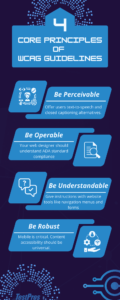Are you an instructional designer or e-learning developer looking to create inclusive and accessible digital content? Look no further than the “WCAG Compliance And Accessibility Standards For Instructional Designers And E-learning Developers.” This innovative product is specifically designed to help you meet WCAG compliance and accessibility standards, ensuring that your e-learning materials can be accessed and enjoyed by all. With its user-friendly interface and comprehensive guidelines, this tool will empower you to design and develop inclusive digital content that caters to diverse learners. Say goodbye to accessibility barriers and hello to a more inclusive learning experience.

Understanding WCAG Compliance
What is WCAG?
WCAG stands for Web Content Accessibility Guidelines. It is a set of guidelines developed by the World Wide Web Consortium (W3C) to ensure that web content is accessible to all users, including those with disabilities. WCAG provides a framework for creating accessible websites and digital content, making it easier for people with disabilities to perceive, understand, navigate, and interact with online content.
Why is WCAG important for instructional designers and e-learning developers?
As instructional designers and e-learning developers, it is our responsibility to create inclusive and accessible learning experiences for all learners. WCAG compliance is crucial in ensuring that our digital content, such as online courses and educational materials, can be accessed and used by everyone, regardless of their abilities. By adhering to WCAG guidelines, we can remove barriers and provide equal opportunities for individuals with disabilities to access and engage with educational content.
Key principles of WCAG compliance
WCAG compliance is based on four key principles: perceivable, operable, understandable, and robust.
-
Perceivable: This principle requires that all information and user interface components be presented in a way that can be perceived by all users, including those with visual, auditory, or cognitive impairments. This includes providing alternative text for images, captions for videos, and clear content organization.
-
Operable: To meet the operable principle, instructional designers and e-learning developers should ensure that all functionality can be accessed and operated by a variety of input devices used by people with disabilities, such as keyboards, assistive technologies, and voice recognition software. This includes providing keyboard accessibility, clear navigation, and predictable interactions.
-
Understandable: The understandable principle emphasizes the importance of making content clear and easy to understand for all users. This involves using plain language, providing instructions and feedback, and organizing content in a logical and predictable manner. Clear instructions and feedback help users better understand and navigate through the content.
-
Robust: The robust principle aims to ensure that content is compatible with a wide range of assistive technologies and future web technologies. By following coding standards and best practices, instructional designers and e-learning developers can create content that can be reliably interpreted and accessed by different tools and devices.
WCAG Level A Guidelines
Overview of Level A guidelines
Level A is the basic level of WCAG compliance. Following the Level A guidelines ensures that the most fundamental accessibility requirements are met. These guidelines address common barriers faced by users with disabilities.
Examples of Level A accessibility standards for instructional designers and e-learning developers
- Provide alternative text for all non-text content, such as images, charts, and diagrams, so that users with visual impairments can understand the content through screen readers.
- Ensure that all color-critical information is not conveyed solely through color, as individuals with color blindness may not be able to perceive color differences.
- Provide clear and consistent headings and labels for all content, making it easier for users to navigate and understand the structure of the information.

WCAG Level AA Guidelines
Overview of Level AA guidelines
Level AA builds upon the Level A guidelines and offers a higher level of accessibility. Following the Level AA guidelines ensures that a wider range of users can access and use the digital content. These guidelines address more complex accessibility issues and provide additional support for users with disabilities.
Examples of Level AA accessibility standards for instructional designers and e-learning developers
- Provide captions for all videos to ensure that users with hearing impairments can access the audio content.
- Ensure that interactive elements, such as buttons and form controls, are accessible through keyboard navigation, allowing users who cannot use a mouse to interact with the content.
- Use clear and simple language in instructional materials, avoiding complex jargon or terminology that may be difficult for some users to understand.
WCAG Level AAA Guidelines
Overview of Level AAA guidelines
Level AAA is the highest level of WCAG compliance. Following the Level AAA guidelines ensures the highest level of accessibility for users. These guidelines address the most advanced accessibility issues and provide extensive support for users with disabilities.
Examples of Level AAA accessibility standards for instructional designers and e-learning developers
- Provide sign language interpretation for all video content, making it accessible to individuals with hearing impairments who rely on sign language to understand the information.
- Ensure that all web pages can be navigated and operated using only the keyboard, without the need for a mouse or other pointing device.
- Provide alternative ways for users to locate content, such as a site map or search functionality, to facilitate navigation for individuals with cognitive disabilities.

Creating Accessible Content
Text alternatives for non-text content
When creating digital content, it is important to provide text alternatives for non-text content, such as images, charts, and graphs. This is essential for individuals who cannot perceive the visual content and rely on screen readers or Braille displays to access the information. Descriptive alternative text should be used to convey the meaning and context of the non-text content.
Captioning and audio descriptions
For video and audio content, captioning and audio descriptions should be provided. Captions include both dialogue and relevant sound effects, enabling individuals with hearing impairments to understand the audio content. Audio descriptions, on the other hand, provide additional information about the visual elements of the content for individuals with visual impairments.
Contrast and color accessibility
Ensuring sufficient contrast between text and background colors is essential for individuals with low vision or color blindness. High contrast enhances readability and makes it easier for users to perceive the text. It is important to choose color combinations that meet WCAG guidelines for contrast ratios. Additionally, avoid using color as the sole means of conveying information, as some individuals may have difficulty perceiving certain colors.
Keyboard accessibility
Keyboard accessibility is crucial for individuals who are unable to use a mouse or other pointing device. All interactive elements, such as buttons, links, and form controls, should be accessible and operable using only the keyboard. Proper focus indication and logical navigation are important aspects of keyboard accessibility, ensuring that users can move through the content easily and efficiently.
Design for screen readers
Screen readers are assistive technologies that read the content aloud for individuals with visual impairments. When designing for screen readers, it is important to provide a clear and logical content structure using appropriate HTML markup. Providing headings, lists, and descriptive link text helps screen reader users navigate and understand the content more effectively.
Ensuring content is perceivable and understandable
To ensure that content is perceivable and understandable, it is important to use clear and concise language, avoid complex sentence structures, and organize content in a logical manner. Providing headings, subheadings, and bullet points can help users scan and comprehend the information more easily. Additionally, providing audio or video transcripts and offering alternative formats for downloadable documents can enhance accessibility for users with different needs.
Navigating the User Interface
Logical and consistent navigation
Creating a logical and consistent navigation structure is crucial for providing a seamless user experience. Users should be able to easily find and navigate to different sections of the website or e-learning course. Clear and descriptive menu items, breadcrumb navigation, and a well-organized page hierarchy contribute to effective navigation.
Skip navigation links
Skip navigation links are useful for individuals who use screen readers or keyboard navigation. These links allow users to skip repetitive content, such as navigation menus, and jump directly to the main content of the page. Skip navigation links enhance efficiency and accessibility for users who may have difficulty navigating through long lists of menu items.
Providing clear instructions and feedback
Clear instructions and feedback are essential for users to understand how to interact with the interface and complete tasks. Instructions should be concise, easy to understand, and provided in a consistent manner. Feedback should be provided in real-time to inform users about the status of their actions and guide them through the process.
Responsive design for different devices
With the increasing use of mobile devices, it is important to ensure that websites and e-learning courses are responsive and adaptable to different screen sizes and resolutions. Responsive design enables users to access and navigate the content effectively, regardless of the device they are using. Scaling text, adjusting layout and navigation, and optimizing images contribute to a better user experience across various devices.
Handling focus and tabindex
Focus management is an important aspect of keyboard accessibility. Users should be able to distinguish where the keyboard focus is within the interface. Clear and visible focus indicators, such as a highlighted border or change in color, help users navigate the content and understand their current location. Additionally, tabindex can be used to control the order in which elements receive focus, ensuring a logical and predictable navigation flow.
Considering cognitive and learning disabilities
When designing the user interface, it is important to consider the needs of users with cognitive and learning disabilities. Clear and concise language, simple instructions, visual cues, and consistent design elements can help individuals with cognitive impairments understand and interact with the content more effectively. Providing options for customization and personalization can also enhance the learning experience for users with diverse needs.

Multimedia and Interactive Elements
Video and audio accessibility
Videos and audio content should be made accessible through techniques such as providing captions, audio descriptions, and transcripts. Captions ensure that users with hearing impairments can understand the dialogue and audio content, while audio descriptions provide additional information about the visual elements for users with visual impairments. Transcripts provide a text-based alternative for users who prefer reading or have difficulty accessing the audio or video content.
Transcripts and closed captions
Transcripts and closed captions should be provided for videos and audio content. Transcripts are a text-based version of the audio content that can be read by users who cannot access or understand the audio. Closed captions, on the other hand, are synchronized with the video and provide a visual display of the audio content, including dialogue, sound effects, and speaker identification.
Accessible interactive elements and quizzes
Interactive elements, such as buttons, quizzes, and form controls, should be made accessible to all users. This includes providing appropriate alternative text, clear labels, keyboard accessibility, and understandable instructions. Users should be able to interact with the elements using a keyboard or other input devices and receive feedback about their actions.
Providing alternatives for Flash and other inaccessible technologies
Flash and other technologies that are not accessible should be avoided. Instead, accessible alternatives such as HTML5, CSS, and JavaScript should be used to ensure that content can be accessed by a wide range of devices and assistive technologies. Providing accessible alternatives ensures that users with disabilities have equal access to the content without encountering any barriers.
Forms and Input Elements
Accessible form design
Forms are an integral part of many websites and e-learning courses. Accessible form design involves utilizing appropriate form controls, using clear and descriptive labels, providing helpful error messages, and organizing the form elements in a logical and intuitive manner. Clear instructions should be provided to guide users through the form completion process.
Control labeling and error messages
Clear and descriptive labels should accompany form controls to provide users with guidance and context. Error messages should be displayed when users make mistakes or omit required information. These messages should be communicated in a clear and understandable manner, helping users identify and correct errors effectively.
Keyboard accessibility for input fields
Input fields, such as text boxes, dropdowns, and checkboxes, should be accessible and operable using only the keyboard. Users should be able to navigate to the input fields using the Tab key, enter information, and submit the form without the need for a mouse. Providing clear focus indication and appropriate keyboard navigation flow ensures a seamless user experience.
Providing clear instructions and visual cues
Instructions and visual cues are essential for users to understand how to complete the form and provide the required information. Clear and concise instructions, preferably provided both above and within the form fields, help users complete the form accurately. Visual cues, such as highlighting or color changes, can also assist users in understanding their current location within the form.

Assistive Technologies and Compatibility
Understanding assistive technologies
Assistive technologies are software or hardware tools that assist individuals with disabilities in accessing and using digital content. Examples of assistive technologies include screen readers, screen magnifiers, voice recognition software, and alternative input devices. Understanding how these technologies work can help instructional designers and e-learning developers create accessible content that is compatible with these tools.
Designing for compatibility and responsiveness
To ensure compatibility with assistive technologies, it is important to follow coding standards and best practices. Proper HTML markup, semantic structure, and adherence to web accessibility standards contribute to a more compatible and accessible user experience. Additionally, designing responsive web pages and e-learning courses ensures that the content can adapt and be fully accessible across different devices.
Testing and evaluating accessibility with assistive technologies
Testing the accessibility of digital content using assistive technologies is an important step in the development process. By testing content with screen readers, keyboard navigation, and other assistive technologies, instructional designers and e-learning developers can identify any accessibility barriers and make the necessary improvements. Regular evaluations and user testing are essential to ensure ongoing WCAG compliance.
Keeping Up with WCAG Compliance
WCAG version updates
WCAG guidelines are periodically updated to reflect advancements in technology and changes in accessibility requirements. Staying informed about the latest WCAG version updates is crucial for instructional designers and e-learning developers to ensure that their digital content remains compliant with the most current accessibility standards. Regularly reviewing the WCAG documentation and staying connected with accessibility communities can help professionals stay up-to-date.
Staying informed about accessibility best practices
In addition to WCAG compliance, keeping up with accessibility best practices is important for instructional designers and e-learning developers. New techniques, tools, and research are constantly emerging in the field of accessibility. By staying informed through professional organizations, conferences, webinars, and online resources, professionals can continue to enhance their knowledge and skills to create more inclusive learning experiences.
Continuing education and professional development
To further develop their expertise in WCAG compliance and accessibility, instructional designers and e-learning developers can pursue continuing education and professional development opportunities. These may include courses, certifications, workshops, and online training programs specifically focused on web accessibility and inclusive design. These opportunities not only deepen understanding but also demonstrate a commitment to creating accessible content.
By understanding the importance of WCAG compliance and adhering to the guidelines, instructional designers and e-learning developers can play a pivotal role in making digital content accessible to all learners. Through creating accessible content, considering the needs of individuals with disabilities, and staying informed about best practices, we can foster an inclusive learning environment that benefits every learner.



